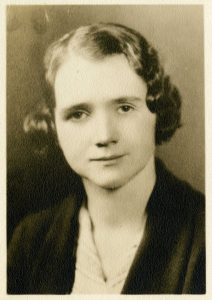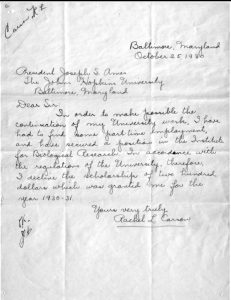Enjoy this post by Jade Robinson, one of our Special Collections Freshman Fellows for the 2020-2021 academic year!
Hi, everyone! My name is Jade Robinson, and I am one of four Freshman Fellows for 2020-21. These past few months I have been exploring Rachel Carson’s time as a graduate student at Hopkins, as well as the history of women at Hopkins. To preface, Rachel Carson played a revolutionary role in the campaign for sustainable business practices and understanding the repercussions of certain chemicals on the environment. Her work was so impactful that the president at the time, and other world leaders, were compelled to investigate her findings.
played a revolutionary role in the campaign for sustainable business practices and understanding the repercussions of certain chemicals on the environment. Her work was so impactful that the president at the time, and other world leaders, were compelled to investigate her findings.
Throughout my research, it seems clear that Rachel Carson exhibited some true Hopkins ideals even before she set foot in Baltimore: diversity, curiosity, and resilience. Her path towards Johns Hopkins University started during her undergraduate career at the Pennsylvania College for Women (now Chatham University, near Pittsburgh). During her studies, she consistently struggled between her two passions, biology and writing, just like many of us at Hopkins (including me!) who decide to double major or minor in conflicting fields. Her biology professor, Mary Scott Skinker, completely altered the trajectory of Rachel’s life. She served as Carson’s mentor, advisor, and friend, both academically and socially. When Skinker decided to pursue a graduate career at Johns Hopkins, it was no surprise that Rachel Carson was inspired and seemed to follow in her footsteps.
Rachel Carson’s time at Hopkins was tumultuous, seeming to always be affected by her family and financial situation. While she received a full tuition scholarship for $200 (shocking, I know), Carson unfortunately had to give it up after she shifted from a full-time to part-time graduate student. This decision, while difficult for her, was necessary because she was the sole provider for her family. She pursued part-time jobs including multiple teaching jobs in the Baltimore area. One of these jobs lead to the Bureau of Fisheries, where Rachel Carson discovered how to intertwine writing and her interest in life sciences. This endeavor compelled her to write a series of best-selling books, which highlighted the influence of nature on human life; and finally, the book that catapulted her into the spotlight: Silent Spring.
I love learning more about the upbringing and education of such a monumental woman in science. There is so much more I have learned, and will continue to learn, about Rachel Carson and the trailblazing women who aided in the introduction of undergraduate coeducation at Johns Hopkins University, despite many opponents. I’m looking forward to sharing all this information soon!
